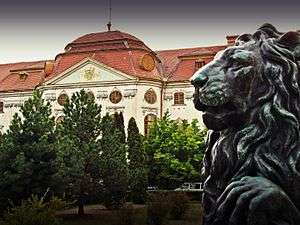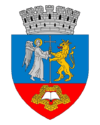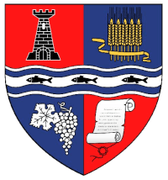Oradea
| Oradea Nagyvárad | |||
|---|---|---|---|
| City | |||
|
From left: Overview of the city center, Oradea City Hall, Greek Catholic Diocese Palace, Black Eagle Palace, Astoria Hotel, Roman Catholic Episcopal palace | |||
| |||
 Oradea Location of Oradea | |||
| Coordinates: 47°04′20″N 21°55′16″E / 47.07222°N 21.92111°ECoordinates: 47°04′20″N 21°55′16″E / 47.07222°N 21.92111°E | |||
| Country |
| ||
| County | Bihor County | ||
| Government | |||
| • Mayor | Ilie Gavril Bolojan (National Liberal Party) | ||
| Area | |||
| • City | 115.56 km2 (44.62 sq mi) | ||
| Elevation | 142 m (466 ft) | ||
| Population (2011 census) | |||
| • City | 196,367 | ||
| • Rank | 10th (Romania) | ||
| • Density | 1,257/km2 (3,260/sq mi) | ||
| • Metro | 245,537 | ||
| Time zone | EET (UTC+2) | ||
| • Summer (DST) | EEST (UTC+3) | ||
| Postal code | 4101xx | ||
| Area code(s) | (+40) 59 | ||
| Vehicle registration | BH | ||
| Official language | Romanian | ||
| Recognized minority language | Hungarian[1] | ||
| Patron saint | Saint Ladislaus[2] | ||
| Climate | Dfb | ||
| Website |
www | ||
Oradea (Romanian pronunciation: [oˈrade̯a]; German: Großwardein, Hungarian: Nagyvárad, Hungarian pronunciation: [nɒɟvaːrɒd], colloquially also Várad, former Turkish: Varat, Yiddish: גרויסווארדיין Groysvardeyn) the capital city of Bihor County and Crișana region, is one of the important centers of economic, social and cultural development in the western part of Romania, retaining these characteristics throughout history. The city is nestled between the hills that separate and unify in a harmonious way with plain Crișana. Located on the banks of Crișul Repede River, that divides the city into almost equal halves, it is the gateway to Central and Western Europe. The city is located in the north-west of Romania.
Located about 10 km (6.2 mi) from Borș, the most important crossing point on the west border (with Hungary), Oradea ranks tenth in size among Romanian cities; it covers an area of 11,556 hectares (28,560 acres). The city is at an altitude of 126 m above sea level, in the opening of the Criș valley and the plain area, in an area of contact between the extensions of the Apuseni Mountains and the extended plain Crișana-Banat. It lies as the area of transition from relief hills, to the Pannonian plain. City topoclimatic action is determined by the prevailing Western winds. Climate is Temperate Continental (Köppen climate classification Dfb), with some oceanic influences.
Geography
The city lies at the meeting point of the Crișana plain and the Crișul Repede's basin. It is situated 126 meters above sea level, surrounded on the north-eastern part by the hills of Oradea, part of the Șes hills. The main part of the settlement is situated on the floodplain and on the terraces situated down the river Crișul Repede. Oradea is famous for its thermal springs. The river Crişul Repede crosses the city right through the center, providing it with a picturesque beauty. Its flow depends on the season; the dykes near Tileagd have partly controlled it since they were built in the early 1980s.
Annual average temperature is 10.4 °C (50.7 °F). In July the average is about 21 °C (70 °F), while in January the average is 1.4 °C (34.5 °F). Rainfall is enough to support the woods and vegetation of the zone, registering an annual average of about 585.4 mm (23.05 in). Rainfall is variably distributed throughout the year, with a maximum in June and a minimum in the late Autumn and Winter months of the year.
| Climate data for Oradea | |||||||||||||
|---|---|---|---|---|---|---|---|---|---|---|---|---|---|
| Month | Jan | Feb | Mar | Apr | May | Jun | Jul | Aug | Sep | Oct | Nov | Dec | Year |
| Average high °C (°F) | 1.4 (34.5) |
4.7 (40.5) |
10.7 (51.3) |
16.9 (62.4) |
22.1 (71.8) |
24.9 (76.8) |
27.1 (80.8) |
26.8 (80.2) |
23.0 (73.4) |
17.1 (62.8) |
9.3 (48.7) |
3.4 (38.1) |
15.62 (60.11) |
| Average low °C (°F) | −5.2 (22.6) |
−2.7 (27.1) |
1.0 (33.8) |
5.5 (41.9) |
10.1 (50.2) |
12.9 (55.2) |
14.2 (57.6) |
13.9 (57) |
10.8 (51.4) |
5.9 (42.6) |
1.9 (35.4) |
−2.4 (27.7) |
5.49 (41.88) |
| Average precipitation mm (inches) | 39.5 (1.555) |
30.3 (1.193) |
36.5 (1.437) |
44.9 (1.768) |
63.4 (2.496) |
90.5 (3.563) |
69.1 (2.72) |
55.2 (2.173) |
39.9 (1.571) |
37.9 (1.492) |
46.6 (1.835) |
49.4 (1.945) |
603.2 (23.748) |
| Source: Administrația Natională de Meteorologie[3] | |||||||||||||
History

While modern Oradea is first mentioned in 1113, under the Latin name Varadinum in a diploma belonging to a Benedictine Zobor Abbey - Bishop Sixtus Varadiensis and Saul de Bychar are mentioned in the document - recent archaeological findings, in and around the city, provide evidence of a more or less continuous habitation since the Neolithic. The Dacians and Celts also inhabited the region. After the conquest of Dacia the Romans established a presence in the area, most notably in the Salca district of the city and modern day Băile Felix.[4][5]
The settlement that would become the city of Oradea is considered to have been relatively unimportant until the 11th century when King Ladislaus I of Hungary founded a bishopric near it, the present Roman Catholic Diocese of Oradea. The city flourished both economically and culturally during the 13th century. It was at this time that the Citadel of Oradea, first mentioned in 1241 during the Mongol invasion, was first built. It would be destroyed and rebuilt several times over the course of following centuries. The 14th and 15th centuries would prove to be of the most prosperous periods in the city's history up to that point. Many works of art would be added to the city, including: statues of St. Stephen, Emeric and Ladislaus (before 1372) and the equestrian sculpture of St. Ladislaus (1390) were erected in Oradea. St. Ladislaus' fabled statue was the first proto-renaissance public square equestrian in Europe. Bishop Andreas Báthori (1329–1345) rebuilt the cathedral in Gothic style. From that epoch dates also the Hermes, now preserved at Györ, which contains the skull of King Ladislaus, and which is a masterpiece of the Hungarian goldsmith's art. It was at this time that astronomer Georg von Peuerbach wrote his Tabula Varadiensis, published posthumously in 1464, Observatory of Varadinum, establishing the city's observatory as the Earth's point of reference and prime meridian.
In 1474, the city was captured by the Turks after a protracted siege. Their mostly tolerant policies towards others peoples ensured that the city would become an ethnic mosaic of Romanians, Hungarians, Austrians, Slovaks, Hebrews, Ruthenians and Turks,[6][7] causing Oradea to grow as an urban area starting with the 16th century.
After the Ottoman invasion of Hungary, in the 16th century, the city became a constant point of contention between the Principality of Transylvania, the Ottoman Empire and the Habsburg Monarchy. The Peace of Várad was concluded between Emperor Ferdinand I and John Zápolya here on 4 February 1538, in which they mutually recognized each other as legitimate monarchs. Following Michael the Brave's conquest of the Principality of Transylvania, the Ottomans sent a punitive expedition that laid siege to the city in 1598, however the siege failed. After Michael's assassination in 1601 and the Peace of Vienna of 1603, the city was permanently incorporated in the Principality of Transylvania by imperial decree. As a result of Gyorgy Rakoczi II's, at the time Prince of Transylvania failed attempt to gain the throne of Poland the Ottomans sent yet another punitive expedition against him and his Wallachian and Moldavian allies. The expedition failed, but it gave the Romanian chronicler Miron Costin the occasion to write the first full chronicle about the city, Oradiia. In 1660 the Ottomans, with a force of 45000 men, besieged the city for the last time. The 850 defenders managed to hold out for 46 days, but eventually the city fell on the 27th of August due to internal treachery. The Ottomans would establish the city as the capital of the newly formed Eyalet of Varat. The eyalet included the sanjaks of Varat (Oradea), Salanta, Debreçin, Halmaș, Sengevi and Yapıșmaz. The siege itself is described in detail by Szalárdy János in his contemporary chronicle. Ottoman dominance of the city ended in 1692, when, the Habsburg imperial forces conquered the city after a 14-month siege.
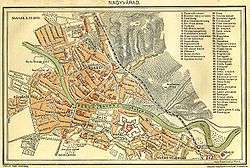
Under the Habsburgs, the city entered its golden age. The Viennese engineer Franz Anton Hillebrandt given the task of planning the city in the Baroque style and, starting with the year 1752, many of the city's current landmarks were constructed such as the Roman Catholic Cathedral, the Moon Church, the State Theatre and the Baroque Palace, presently the Muzeul Țării Crișurilor ("The Museum of the Criș land"). The city played a major role in the Hungarian Revolution of 1848, being the home of the largest Hungarian arms factory.
At the end of World War I, as a result of the National Assembly of Alba Iulia and the Hungarian-Romanian war of 1919, Oradea became a part of the Kingdom of Romania under the Treaty of Trianon. The Second Vienna Award brokered by Hitler and Mussolini in 1940 allowed Hungary to recover Northern Transylvania, including Oradea, where mass of celebrators welcomed the Hungarian administration.[8] On 12 October 1944, Oradea was captured by Soviet troops of the 2nd Ukrainian Front in the course of the Battle of Debrecen. After World War II, Hungary had to relinquish claims to it under the Treaty of Paris concluded on 10 February 1947.
In 1925, the status of municipality was given to Oradea dissolving its former civic autonomy. Under the same ordinance, its name was changed from Oradea Mare ("Great" Oradea) to simply Oradea.
Ethnic tensions sometimes ran high in the area in the past but the different ethnic groups now generally live together in harmony, thriving on each other's contributions to modern culture.
After December 1989, Oradea aims to achieve greater prosperity along with other towns in Central Europe. Both culturally and economically, Oradea's prospects are inevitably tied to the general aspiration of Romanian society to freedom, democracy and a free market economy, with varied initiatives in all fields of endeavor. Due to its specific character, Oradea is one of the most important economic and cultural centers of Western Romania and of the country in general, and one of the great academic centers, with a unique bilingual dynamic.
Kings buried
- 1096 Ladislaus I of Hungary
- 1131 Stephen II of Hungary
- 1235 Andrew II of Hungary
- 1295 Fenenna, wife of Andrew III of Hungary
- 1319 Beatrice of Luxembourg, wife of Charles I of Hungary
- 1367 Elizabeth, daughter of Basarab I of Wallachia
- 1395 Mary of Hungary
- 1437 Sigismund, Holy Roman Emperor, King of Hungary
Demographics
| Historical population of Oradea[9][10] | |||||||||||||
| Year | Population | %± | Romanian | Hungarian | |||||||||
|---|---|---|---|---|---|---|---|---|---|---|---|---|---|
| 1787 | 9,790 | — | n/a | n/a | |||||||||
| 1830 | 19,091 | 95% | n/a | n/a | |||||||||
| 1857 | 22,443 | 17.5% | n/a | n/a | |||||||||
| 1880 | 31,324 | 39.5% | 6.5% | 86.8% | |||||||||
| 1900 | 47,018[11] | 50.1% | n/a | n/a | |||||||||
| 1910 census | 64,169 | 36.4% | 5.6% | 91% | |||||||||
| 1930 census | 82,687 | 28.8% | 27.1% | 51.5% | |||||||||
| 1948 census | 82,282 | −0.4% | 32.8% | 63.8% | |||||||||
| 1956 census | 98,950 | 20.2% | 35.9% | 59% | |||||||||
| 1966 census | 122,534 | 23.8% | 46% | 51.3% | |||||||||
| 1977 census | 170,531 | 39.1% | 53.9% | 44% | |||||||||
| 1992 census | 222,741 | 30.6% | 64.7% | 33.3% | |||||||||
| 2002 census | 206,614 | −7.2% | 70.3% | 27.5% | |||||||||
| 2011 census | 196,367 | −4.9% | 73.1% | 24.9% | |||||||||
At the 2011 census Oradea had a population of 196,367, a decrease from the figure recorded at the 2002 census.[12]
The ethnic makeup is as follows:[13]
- Romanians: 132,718 (73.1%)
- Hungarians: 45,305 (24.9%)
- Roma: 2,132 (1.2%)
- Other: 1,507 (0.8%)
(Data refer to those for whom information on ethnicity is available. It is unavailable for 14,705 individuals or 7.5% of the city's population.)
The religious makeup is as follows: 59.8% Romanian Orthodox, 14.3% Reformed, 9.4% Roman Catholic, 5% Pentecostal, 3.7% Baptist, 3.4% Greek-Catholic and 4.4% other, undeclared or none.[14]
Jewish community

- This section incorporates text from the 1901–1906 Jewish Encyclopedia, a publication now in the public domain.
The chevra kadisha ("holy society") was founded in 1735, the first synagogue in 1803, and the first communal school in 1839. Not until the beginning of the 19th century were Jews permitted to do business in any other part of the city, and even then they were required to return at nightfall to their own quarter. In 1835, permission was granted to live in any part of the city.
The Jewish community of Oradea became divided into Orthodox and Neolog congregations. While the members of the Neolog congregation still retained their membership in the chevra kadisha, they started to use a cemetery of their own in 1899. In the early 20th century, the Jews of Oradea had won prominence in the public life of the city. There were Jewish manufacturers, merchants, lawyers, physicians, and farmers; the chief of police (1902) was a Jew; and in the municipal council, the Jewish element was proportionately represented. The community possessed, in addition to the hospital and chevra kadisha, a Jewish women's association, a grammar school, a trade school for boys and girls, a yeshiva, a soup kitchen etc.
According to the Center for Jewish Art:
The Oradea Jewish community was once the most active both commercially and culturally in the Austro-Hungarian Empire. In 1944, twenty-five thousand Oradean Jews were deported to concentration camps by the Nazis, thus decimating this vital community. Only three hundred Jews reside in Oradea today. In the center of the city, on the river bank and towering over other buildings in the area, is the large Neolog Temple Synagogue built in 1878. The unusual cube-shaped synagogue with its large cupola is one of the largest in Romania. Inside there is a large organ and stucco decorations. In 1891, the Orthodox community also built a complex of buildings including two synagogues and a community center.[15]
In 1944, during the occupation of Hungary by Nazi Germany, Hungarian authorities forced the Jewish inhabitants into the Oradea ghetto before sending them to the Auschwitz concentration camp. Descendants of the pre-Holocaust hasidic rabbinate in Oradea established a synagogue in the Willowbrook area of Staten Island, New York. The synagogue maintains both a traditional hasidic Nusach Sefard and a Nusach Ashkenaz service, the latter of which operates under the name Bais Medrash Igud Avreichim of Groisverdain (the Yiddish pronunciation of Grosswardein).
Quarters
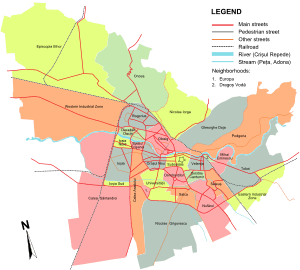
Before 1848, Oradea was made up of 4 separate towns: Várad-Újváros (Villa Nova, former Vicus Szombathely), Várad-Olaszi (Villa Latinorum Varadiensium, "olasz" meaning Italian), Várad-Velence (Vicus Venetia), Várad-Váralja (Civitas Waradiensis). The names Vicus Venetia, Villa Latinorum, Vicus Bolognia, Vicus Padua and others refer to the French, Walloons and Italian inhabitants who settled in the 13th century.
Today the city is made up of the following districts called quarters (cartiere in Romanian, negyedek in Hungarian):
|
Economy
Oradea has long been one of the more prosperous cities in Romania. The per capita GDP of Oradea is approximately 150% of the Romanian average.[16] After 1989, due to its important base of consumers, Oradea enjoyed an economic renewal, not so much in industry but rather in the services sector such as trade and tourism.
Oradea has an unemployment rate of 6.0%, slightly lower than the Romanian average but much higher than Bihor County's average of around 2%. Oradea currently produces around 63% of the industrial production of Bihor County while accounting for 34.5% of the population of the county. Its main industries are furniture, textiles and clothing, footwear and food processing. Oradea economy is sustained largely by small and medium business and the property taxes paid by citizens.
In the fiscal year 2012, Oradea had the largest budget in the Transylvania region, overcoming its neighbour cities, Arad and Cluj-Napoca.[17] Some large Romanian companies, such as Adeplast, RCS-RDS, European Drinks or FrigoExpress are located in Oradea.
Transport

The public transport network is run by OTL, a municipal agency. It is made up of three tram lines (1R, 1N, 2, 3R, 3N) and 17 local bus lines (numbered from 10 to 26), and an international suburban one to Biharkeresztes, Hungary. The city has four train stations: Central, West, East and Episcopia Bihor (Bihor Abbey). The West Station is located in the quarter of Ioşia, the Central station (called simply Oradea) is located closer to the city center, near the quarter of Vie, while the East station is located in Velenţa.
Oradea is served by Oradea International Airport, which has reopened at the end of 2015, after repairs to the runway.
Education
Oradea is one of the main education centers of Romania. The city is home to the University of Oradea, one of the largest universities in the country. There are also several private universities, one being Agora University, a modern academic institution founded in 2000. Emanuel University, a Baptist school, also exists in the city since 2002.[18]
The traditions of higher education in Oradea, metaphorically speaking, go back to time immemorial. This year 2012 there are 232 years since the inauguration of higher education in Oradea and 48 years of continuous higher education in Oradea.
At the end of the 18th century, "a higher institution for philosophic teaching" is founded in Oradea in 1780, which was to become in 1788 the Faculty of Law, the oldest faculty not only within the Romanian borders but also in a vast region of Eastern Europe.
After 1921, all the courses at the Law Faculty were taught in Romanian. In 1923, the foundation of two theological academies gave new dimensions to the academic life in Oradea.
The Law Academy of Oradea, together with the two theological academies, was to make another step forward by integrating a faculty of letters, thus achieving the old desideratum of creating a University of Crisana in Oradea.
After a thirty-year break in the activity of the Law Academy of Oradea, on 1 October 1963, an order of the Ministry of Education established in Oradea a 3-year Pedagogic Institute meant to do away with the scarcity of teachers in secondary education. The new institution of higher education began its activity with two faculties: Philology and Mathematics-Physics, and a year later other two faculties (History-Geography and Physical Education) were added.
In May 1990, a decree of the Romanian Government established the Technical University of Oradea, later called the University of Oradea, and based on impressive traditions of academic life in the town. It was an act of scientific and cultural restoration long expected in the life of the Romanian society, a major gain of the people's Revolution of December 1989, one of the greatest Romanian achievements in Crisana after the Great Union on 1 December 1918. This is how the dream of several generations of scholars came true, clearly expressed by a historian of Oradea: "As regarding the future, the desire of all well-meant Romanians is to establish in Oradea a complete university, the lights of which will shine across the entire western border of Romania". Today, the University of Oradea is an integrated institution of higher education of this kind, comprising 18 faculties.
The mission of the University of Oradea is to train and educate on a large scale both the students and also the high education graduates, as well as to approache certain domains of science and technology at high level.
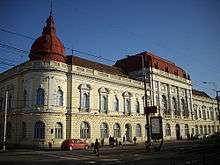
The structure of the University contains academic education, postgraduate education and scientific research.
The University of Oradea expanded itself by developing new faculties and research teams, as well as by developing certain specializations inside the existing faculties.
Inside the University of Oradea the education and research activity is developing in the area of natural and physical sciences, as well as in the area of social and human sciences, covering the following: Mathematics, Physics, Chemistry, Sciences of Life, Agricultural Sciences, Medical Sciences, Technological Sciences, Economical Sciences, Geography, History, Juridical Sciences and Law, Linguistics, Pedagogy, Political Sciences, Psychology, Letters and Arts, Sociology, Philosophy. The educational process is based on the curricula for long undergraduate and postgraduate studies.
One of the oldest private universities in Romania is also situated in Oradea. The Sulyok István Reform College was founded in the spring of 1990 by the Királyhágómelléki Reform Church. In 1999 the school became entirely independent from the Protestant Theology College of Cluj-Napoca and changed its name to Partium Christian University. It presently operates with 12 faculties and a student body of 1400; the language of instruction is Hungarian.
Architecture
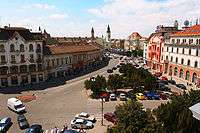
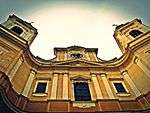

Oradea's current architecture is a mix of Communist-era apartment buildings, mainly in the outer quarters, and beautiful historical buildings that are remnants of the era when the city was part of Austria-Hungary. In addition to many Baroque buildings, Oradea is remarkable for its particularly rich collection of Art Nouveau architecture.
Art Nouveau is easy to discern because of its curved, undulating lines « flowing » naturally, in syncopate rhythms, as a musical leitmotif. The numerous open curved lines – parabolas and hyperbolas – important elements of Art Nouveau “panoply”, give dynamism and rhythm to these buildings and artefacts.
It is fully expressed in decorative arts, design and architecture. The main ornamental characteristic is the asymmetric undulating line, terminated by an energetic whiplash.
Oradea may be considered one of the most representative centres of 1900 architecture in Romania; it can be compared with those of Secession architecture in Central Europe.
Located at the Romanian western border, Oradea was, at the beginning of the 20th century, part of the Central European Austro-Hungarian Empire and, thus, was influenced by the artistic currents of this space.
The buildings of the early 20th century are richly marked by Lechner and Vienna Secession influence, inheriting an important legacy from the great architects of the artistic movement of the late 19th century and the early 20th century. The architecture and habitat of Oradea are to be approached only in the context of Central European architecture.
By its independence and personality, Oradea has a place among the large great European families of the firmly contoured 1900 Art, especially regarding the area between the Citadel and the Main Railway Station. There are here rental buildings, (Moskovits Palace I and II, Apollo Palace, Stern Palace, Adorjan Houses I and II, Darvasy Palace), villas (La Roche, Vágó, Okany Schwartz), hôtels (Pannonia, Emke, Rimonoczy, Weiszlovics, Vulturul Negru), military buildings – on Armatei Române Street, industrial buildings and warehouses (beer-, spirit-, bricks-factories, electric plant’s chimney), public institutions (City Hall, Palace of Orthodox Bishopry, Palace of Greek-Catholic Bishopry, Palace of Justice, banks, houses of commerce and industry etc.), signed by architects who have a prime place in the European 1900 Architecture record: Odon Lechner, Dezső Jakab, Marcell Komor, László and József Vágó, Valér Mende, Ferenc Sztaril, Ferenc Löbl, Kálmán Rimanóczy Sr.and Jr., Anton Szallerbek. All these sites offer a very diverse research and development material. These great architects brought in Oradea the influence of Vienna and Budapest through their work, featuring a new style, different from the academic ones, thus creating the premises of a stylistic diversification based on inventions and originality.

Like many European cities, “Small Paris”, as Oradea was named at the beginning of the last century, has a belle-époque charm given by its Secession, eclectic, New-Romanian, Neoclassic and Baroque architecture. Not impressing by size or opulence, the buildings of Oradea have an aura of welfare, refinement and quality that imprints on the memory. The early 20th century is well represented in the centre, but almost every zone of the city has something especially particular. The history centre of the city has a great historical, cultural, architectural and urban planning heritage value. It includes settlements nuclei, architectural relics, monuments of architecture and urban planning beginning with the 16th century up to a well represented beginning of the 20th century, and none of the monuments is annoying or discordant.
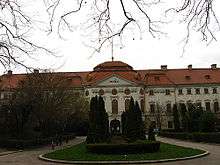
Analyzing the unity of style and ornamentation as an intrinsic value of Art Nouveau, we can find a coherent style combining the architectural structure and its artistic means; stucco mouldings, statues and medallions, ironwork, stained glass, opaque and coloured glass – they all justify ornamentation as a principle of architecture, based on the value of the line, on the organic power of the plant and on the structural symbol. Oradea architecture is a result of the values created by an extremely interesting and valuable ethnic mix, which materialized in a value exchange of a rare richness, and in a shared heritage of great majesty and beauty. In its evident and rare specificity, it appears to be exceptionally valuable. The heritage represents here a unifying element, a social cohesion instrument, which engendered a cultural mosaic and an original synthesis, like the dialects of a language – the result is a stylistic dialect resulting from mutual embellishments and fertilizations.
This contribution, a Romanian stylistic intervention in an important European current, is worth a special attention and a significant promotion, to match the quality, generosity, authenticity and exceptional value of the harmonious resulting interlacing.
The authenticity of the place was very well kept and fed by the previous generations. If the local specificity is not well-preserved, much of the cultural identity, so important in identifying a people, will be lost. The entire community must feel obliged to a greater attention and sensitivity concerning the heritage protection, and the authorities and experts must develop policies and actions to preserve such a valuable heritage. It is necessary to study and know the different views of conservation, to carefully choose the appropriate ones, in order to avoid possible pitfalls that may stem from trying to maintain a balance between conservation and management of the historic city.
Tourist Attractions

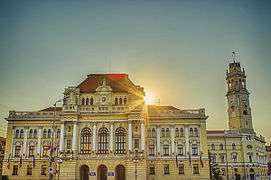
The beautiful city centre is worth visiting, as are the Băile Felix health spas, accessible by bus and located just outside the city.
Other sites worth visiting are:
- Baroque Palace of Oradea – today Muzeul Țării Crișurilor, a wonderful Baroque museum with 365 famous windows. It was the Roman Catholic bishop's palace until 1945, when the Communist regime took the building into public ownership. It was returned to the Roman Catholic Church in 2003. Its collection includes many fossils of dinosaurs and birds from the bauxite mines at Cornet-Brusturi.
- Catedrala barocă – the biggest Baroque cathedral in Romania,
- Cetatea Oradea – Oradea's Fortress, with a pentagonal shape, is a fortification with walls of rock on some portions and wood towers situated at the gate and at the corners.[19]
- Biserica cu Lună – a church unique in Europe, with an astronomical clock depicting the phases of the moon,
- Pasajul Vulturul Negru – the "Black Eagle Palace" (or "Eagle Palace") shopping galleria, named after its famous stained glass eagle in the ceiling
- Ady Endre Museum – a museum dedicated to one of the greatest Hungarian poets and a native son,
- Teatrul de Stat – the State Theatre in the heart of the city, plans for which were designed by two Austrian architects who had built around 100 theaters and opera houses in Europe by the end of the 19th century,
- Str. Republicii – one of the most beautiful streets of Transylvania, displaying a great number of Art Nouveau buildings,
- There are also some 100 religious sites of different denominations in Oradea, including three synagogues (only one still in use) and the biggest Baptist church, Emmanuel Baptist Church, in Eastern Europe.
Sports

CSM Oradea is Oradea's professional basketball club that plays in the country's 1st division Liga Națională and has competed at international competitions such as the EuroChallenge. The team plays its home games at the Arena Antonio Alexe.
FC Bihor, founded in 1958, is the city's representative in the Romanian football system, currently playing in Liga II. It is, indirectly, the successor to the historic Clubul Atletic Oradea (CA Oradea), founded in 1910. Famously, after the annexation of Northern Transylvania by Hungary during WW II, the football club played in the Hungarian Championship under the Hungarian translation Nagyváradi Atlétikai Club (NAC), and won the championship at the end of the 1943–1944 season. CA Oradea is one of only two football clubs who played and won national championships in two countries (the other one is SK Rapid Wien).

During the communist years, a series of football clubs represented the city in the 1st, 2nd, and briefly in the 3rd division, under the names Libertatea, IC Oradea, Progresul, Crişul, CS Oradea, and Crişana, with varying degrees of success, but winning only one Romanian Cup title, won by Progresul in 1956. The current FC Bihor Oradea has been playing primarily in Liga II; club colors are red and blue, and the logo includes the year 1902, when the first football match was played in Oradea in Réday Park. The most famous players who wore the white-and-green jersey of earlier teams from Oradea were Francisc Ronnay, Iuliu Bodola – who played international football for both Hungary and Romania in the 1930s – and Elemér Berkessy. Oradea's 18,000 seat football stadium bears Bodola's name today.
International relations
Twin towns – Sister cities
Oradea is twinned with:
Metropolitan area
Oradea metropolitan area is a metropolitan area located in Western Romania, in the County of Bihor, Crişana Romania and was founded on 9 May 2005.
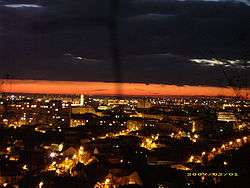
The metropolitan area comprises the city of Oradea and 8 adjacent communes:
Gallery
 The Ferdinand Square
The Ferdinand Square The Faculty of Medicine
The Faculty of Medicine- The Black Eagle Palace
 Baroque Roman Catholic cathedral
Baroque Roman Catholic cathedral The Crișul Repede river
The Crișul Repede river
Natives
- Yehuda Amital, rabbi and former member of Israeli cabinet
- Iuliu Baratky, footballer
- Cosmin Bărcăuan, footballer
- Gabriel Báthory prince of Transylvania
- Sigismund Báthory prince of Transylvania
- Ödön Beöthy, deputy
- Lajos Bíró, novelist, playwright, and screenwriter
- Eliezer Berkovits, rabbi, theologian, and educator
- Iosif Demian, cinematographer and film director
- Emanoil Gojdu, lawyer
- Ernő Grünbaum, expressionist painter
- Endre Kabos, fencer
- Asteris Koutoulas, music producer, publicist and translator
- Mihai Neșu, football player
- Claudiu Keșerü, football player
- Péter Pázmány, philosopher
- Cristian Petre, rugby union player
- Georges Politzer, philosopher
- Titus Popovici, screenwriter
- Friedrich Schorr, opera singer
- Ede Szigligeti, writer
- Reuven Tsur, professor emeritus of Hebrew literature and literary theory
- Júlia Várady, opera singer
- Nandor Wagner, sculptor
See also
Sources
![]() This article incorporates text from a publication now in the public domain: Herbermann, Charles, ed. (1913). "article name needed". Catholic Encyclopedia. New York: Robert Appleton.
This article incorporates text from a publication now in the public domain: Herbermann, Charles, ed. (1913). "article name needed". Catholic Encyclopedia. New York: Robert Appleton.
Notes
- ↑ Law 215/2001 (Romanian: Legea nr. 215 din 2001 a administrației publice locale)
- ↑ Dr. János Fleisz – Szent László Nagyvárad védőszentje. Retrieved 2016-05-19.
- ↑ "Medii lunare multianuale 1961–1990" (in Romanian). Administrația Natională de Meteorologie (Romanian National Administration of Meteorology). Retrieved 2010-07-15.
- ↑ Cataldi Raffaele; Hodgson Susan; Lund John (1999). Stories from a Heated Earth, Our Geothermal Heritage. Geothermal Resources Council. p. 245. ISBN 0934412197.
- ↑ E. J. Brill. Rumanian Studies, Vol. 3. Brill Publishers, Leiden, 1976.
- ↑ Colegiul Național Emanuil Gojdu – Istoria orașului Oradea. Retrieved 2009-05-10.
- ↑ Oradea-Online – Istoria Oradiei. Retrieved 2009-07-21
- ↑ A nagyváradi „verőfényes magyar ünnep” (The "shiny Hungarian holiday" in Oradea), Erdélyi Napló, 4 February, 2009
- ↑ Varga E. Statistică recensăminte după limba maternă, respectiv naționalitate
- ↑ Structura etno-demografică a României la recensământul din 2002
- ↑ Encyclopædia Britannica Eleventh Edition
- ↑ "2011 Census" (PDF) (in Romanian). INSSE. 2 February 2012. Retrieved 10 March 2012.
- ↑
- ↑ Comunicat de presă privind rezultatele preliminare ale Recensământului Populaţiei şi al Locuinţelor – 2011 în judeţul Bihor
- ↑ "Uncovering and Documenting Jewish Art and Architecture in Western Romania". Center for Jewish Art. The Hebrew University of Jerusalem. Summer 1998. Retrieved 2007-03-05.
- ↑ Zona metropolitană Oradea – Prezentare multimedia
- ↑ http://www.romanialibera.ro/actualitate/locale/topul-bugetelor-locale-din-transilvania-si-banat-253725.html
- ↑ Home page of Emanuel University
- ↑ Cetatea Oradea Wikipedia
External links
| Wikimedia Commons has media related to Oradea. |
-
 Oradea travel guide from Wikivoyage
Oradea travel guide from Wikivoyage - Oradea Town Hall (Romanian)




